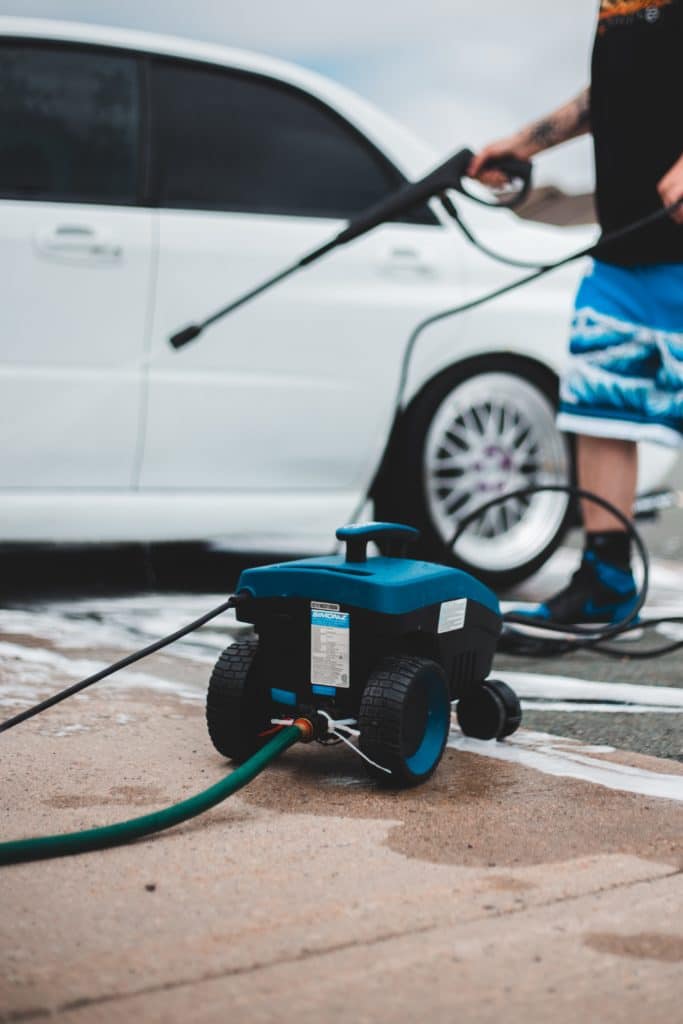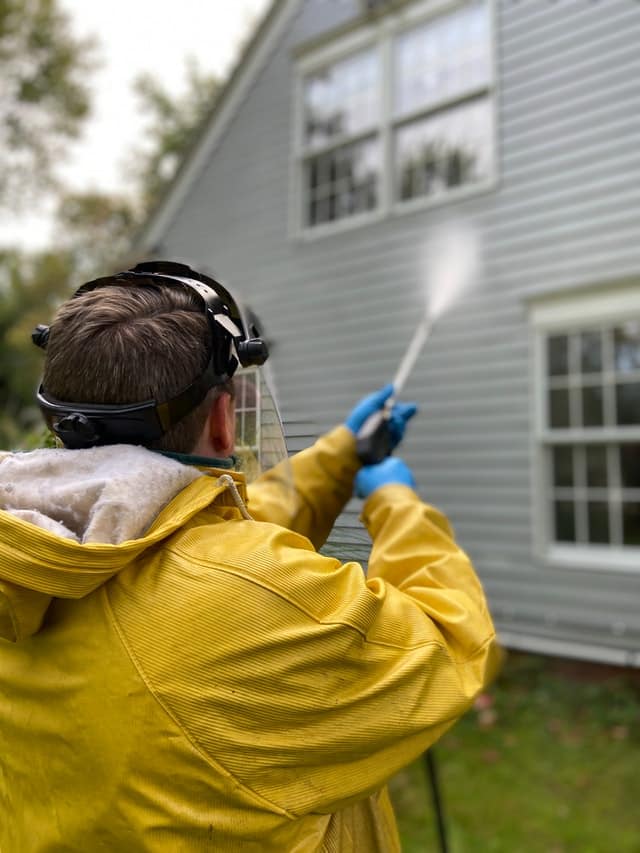There’s nothing more satisfying than watching dirt and grime being blasted away by pressure washers. This popular device has been around since 1926 and is still a favourite for cleaning residential and commercial buildings. In fact, whether you’re new to providing Adelaide cleaning services or a big shot cleaning company in Melbourne, a pressure washer is always a must-have. While removing tough stains from your driveway is doable with just a nylon brush and dishsoap, using a pressure washer can get it done in a fraction of the time.
If you’re new to the world of pressure hosing, there are some nuisances involved during the cleaning process. Going gung-ho when spraying can lead to an accident resulting in a trip to the ER. To avoid any unnecessary injuries and to use your pressure washer the right way, here are some pressure washing tips for beginners:
Wear Safety Gear Before Starting
Pressure hosing is a highly efficient way of cleaning, but it’s also dangerous. Nearby items can become damaged from the forceful spray, causing debris to fly into the air and land on you. Before attempting exterior housing washing or any other project, make sure you wear the following protective gear:
- Safety Goggles
- Earmuffs or Earplugs
- Heavy-duty boots
- Gloves
Start Slow & Gradually Increase Pressure
There’s never a reason to rush when you’re a beginner. Starting gradually will allow you to understand what kind of pressure is appropriate for the surface you’re trying to clean.
When cleaning surfaces, it’s important to remember that the jet’s force may cause blemishes on some surfaces, often removing the finish. For example, when power washing painted concrete, wood or metal, you risk scraping off the paint. To prevent this from happening, test your pressure washer on a few inconspicuous areas first before diving in headfirst.
A Higher PSI means Less Cleaning Time
The stronger the jet, the faster you can clean when pressure hosing. To clean your exterior in the shortest amount of time, choose a pressure washer that has a psi of at least 3100. If you’re unable to find a machine with that kind of power output, opt for one closest to that number.
While you can perform driveway pressure cleaning with a machine that puts out 2000 psi, it will take you much longer to finish the job. That being said, don’t crank up your pressure washer to full blast without testing it first.
Refrain from Staying Still When Pressure Hosing
The last thing your exterior surface needs is a small dent from you being motionless. To ensure your pressure washer doesn’t blast a hole right through your wall (ok, we’re exaggerating here) it’s essential to maintain motion when spraying. Doing so will evenly distribute the spray onto your surface, effectively blasting away more dirt and grime while avoiding unforeseen mishaps.
At the same time, you don’t want to frantically move your arms around like a tube man at a car dealership. When handling your pressure washer, maintain a firm grip when cleaning. It may take a few attempts to get the hang of it, but you’ll be a pro in no time!
For instance, when pressure washing concrete retaining walls, it’s crucial to use the right pressure and technique to avoid damaging the structure. At the same time, you don’t want to frantically move your arms around like a tube man at a car dealership. When handling your pressure washer, maintain a firm grip when cleaning. It may take a few attempts to get the hang of it, but you’ll be a pro in no time!
Pressure Washing Retaining Walls and Concrete Sleepers
When pressure washing retaining walls and concrete sleepers, it’s essential to choose the right equipment and technique to avoid damage. Start by inspecting the structure for any pre-existing damage and clearing away loose debris. Use a pressure washer with an appropriate PSI and a wider angle nozzle for a balance of efficiency and safety. Maintain a consistent distance and motion to evenly clean the surface without focusing excessively on one area. After cleaning, rinse thoroughly and inspect for any damage, applying repairs and sealant as needed to protect the surface.
Choose the Right Power Washing Nozzle
What’s often overlooked when attempting a pressure wash is its attached nozzle. The nozzle is just as important as your device’s psi as it dictates jet pressure. If you choose the wrong nozzle, your pressure hose will be no more effective than a garden hose set on the lowest blast.
Power washers generally come with 4-5 degree nozzles, with the lowest degree settings being the most potent. For fragile surfaces that require a light touch, a 40-degree nozzle provides a broader spray that quickly sweeps away dirt, leaves and other debris. Meanwhile, if you need a more powerful clean capable of removing rust and paint, opt for a 15-degree nozzle.
Maintain Your Equipment to Ensure its Longevity

Your pressure washer’s pump, hoses and spray wand are only as effective as it’s working condition.
When not in use, keep your power washer indoors. However, if you are pressure washing regularly, you can winterize your equipment to prevent water freezing up internally. Do so by filling your pressure washer pump with undiluted RV-type antifreeze. This involves inserting a funnel into a small section of your garden hose and attaching it to the pressure washer water outlet. You can then pour your antifreeze to prevent freezing.
Don’t Pressure Wash Windows
The power from a pressure washer is meant for harder surfaces, not glass and mirrors. In fact, you risk destroying your expensive windows if you happen to shoot water at them directly. The seals that bind your windows can also be removed, allowing water to seep into your home and cause mould and mildew.
In addition to glass, other materials and items you’ll want to avoid pressure hosing include:
Asphalt Shingles: Your jet’s pressure can blast away your shingle’s granules that protect your roof or rip your shingles right off.
Air Conditioners: While effective at cleaning, you risk damaging your air conditioner’s coil and rendering your unit inefficient.
Plantlife: If you wish to maintain an earthy touch throughout your garden, steer clear of the pressure washer.
Stained Wood: For beginners who want to keep their beautiful shade of dark brown on their furniture, stay away from a pressure washer. For more experienced operators, choosing the correct nozzle can mitigate any accidental damage from water.
Wooden Fences: While pressure washing is an effective cleaning method, it’s not recommended for all fence types. For wooden fences, pressure washing can damage the wood, leaving it vulnerable to rot and decay. To keep your wooden fence looking great, contact Sidepost Fencing, they have professional fence contractors across Australia, for expert cleaning and maintenance services.
Looking to pressure wash your wheelie bins? Check out these tips.
Spot-Treat Stains using a Detergent Cleaning Solution
The pressure washer is one of your best friends to clean your backyard or patio thoroughly. But before pressure cleaning everything in your path, ensure you spot-treat any tough stains using detergent.
Make a solution with liquid detergent and water and spray your stains directly. Let sit for at least ten minutes, then use the pressure washer to blast away any remaining residue. The detergent works to soften up stains glued to your surface, making it easier to remove with your pressure washer.
Planning on cleaning your garage? Here’s how!
Pressure Washing FAQ
What is a pressure hose?
A pressure hose is a tube that connects your professional pressure washer to the spray wand. It’s typically made of reinforced rubber diameter around 2 inches to 3 inches. Unlike a standard tube, a pressure hose can withstand the high pressure that comes from your power washer.
Should you rent a pressure washer or pay for a service?
Electing to pay a professional pressure washing service is recommended if you’re not well versed in pressure washing. This way, you’re guaranteed to have a professional-grade clean. However, if you’re up for the challenge and don’t mind a little dirt under your fingernails, expect to pay about $40 a day to rent a pressure washer.
A professional will generally charge by square metres, and the larger the job, the more cost-effective it becomes as the costs come down proportionately. Price will also depend on surface material and the degree of dirt.
Is pressure washing your house worth it?
Yes, it can be beneficial for removing mould and mildew stuck on your walls or siding. Pressure washing can also infuse your patio with new life thanks to its ability to wash away dust, dirt and other debris. It also gets the job done in a fraction of the time, making it one of the most efficient cleaning methods to exist.
Can I use an expanding hose with a pressure washer?
If your expandable hose is rigged to your pressure washer’s water inlet and is running from your faucet, then you absolutely can. However, just ensure not to attach your expandable house from your water outlet to your spray gun.
Conclusion
Pressure washing is a great tool to help maintain your outdoor living areas. But it’s not something you can just jump right into and expect to get the best results. Like any good project, it requires a little bit of planning and some user knowledge before anything else.
Want to learn more about cleaning other materials in your home? Read our Aluminium cleaning guide and learn how to remove tarnish from your cookware and appliances.
If a DIY cleaning job is not for you, you may also look into hiring Calibre Cleaning for any cleaning chores you might have. We provide professional services for house cleaning services in Adelaide, Brisbane, Canberra, Gold Coast, Hobart, Melbourne, Perth, and Sydney. We also offer End of lease or bond cleaning in Adelaide, Brisbane, Canberra, Gold Coast, Hobart, Melbourne, Perth, and Sydney.
